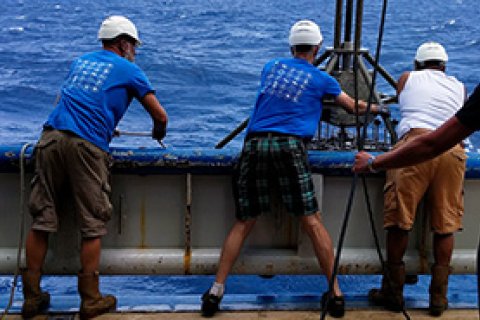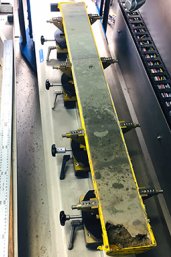Unraveling a muddy catch from the Atlantic
First glimpse of NICO expedition samples
An exciting moment for Earth scientists Dr Martin Ziegler and Ilja Kocken: their first glimpse of the sediment cores they collected in the middle of the Atlantic Ocean on board of the Research Vessel Pelagia. In October they were at the NIOZ on Texel to study their drilling material from the eighth leg of the Netherlands Initiative Changing Oceans (NICO) expedition. Martin Ziegler reports.

Almost half a year after our expedition across the Atlantic Ocean we are at the NIOZ to open two of the sediment cores that we collected in the deep-sea between the Bahamas and Ireland. We took long sediment cores from the water column and the sea floor to reconstruct past changes in the North Atlantic climate and oceanography.
These findings will enable us to put modern climatic changes into a wider context. On board of the RV Pelagia there was not enough time to split the cores so we are very excited to finally get a first look at our ‘catch’.
13 meters of past climate
The two sediment cores are both around 13 meters long, so we first have to cut them into sections of 1 meter. Our first look at the inside of the cores already reveals a lot of variation in the colour and composition of the sediments. This variability is directly linked to past climate change and ocean circulation of the North Atlantic. Soon we also find some small pebbles in the sediments. These so-called ‘dropstones’ demonstrate that icebergs were melting at our core location in the past. When icebergs melt they release sediments from the ice into the deep-sea.
Better predictions
The ultimate goal of our research is to understand how ice sheets respond to global temperature changes. This will also help us to make better predictions on how the ice sheets will respond to current global warming. We gain this understanding from reconstructions of past environmental changes. With the NICO material we develop methods that improve the accuracy of these reconstructions.

Europe covered with ice
The data that Marine Sciences Master student Joris Molenmaker will generate, will allow us to reconstruct Atlantic deep-sea temperature changes over the course of the last 130,000 years. The sediment cores that we opened today contain sediments that were deposited over this time span. Over the last 130,000 years, the world went from a warm interglacial with relatively small ice sheets into an extreme glacial state with large ice sheets covering large parts of North America and Northern Europe and back into an interglacial again.
On 29 November a post cruise meeting will showcase the first scientific results of the entire NICO expedition. The meeting will take place in The Hague and is organised by NWO and NIOZ and chaired by Utrecht University Professor Jack Middelburg, chair of the NICO Scientific Committee.

